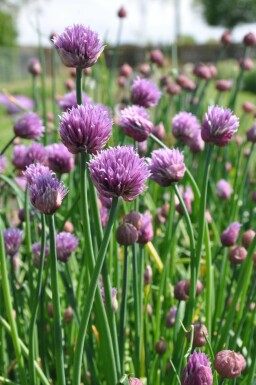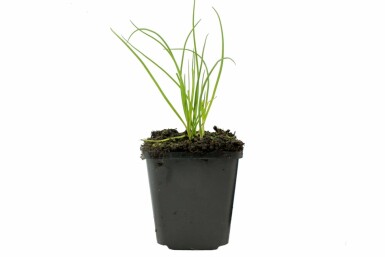

30cm




Updated on 10 September 2025
We regret to inform you that we are currently unable to ship orders to the United Kingdom. We anticipate being able to resume shipments at the beginning of 2026.
Allium adds striking globe-shaped flowers to any garden, creating a graceful bloom accent. Ideal for borders and rock gardens, it's low maintenance and attracts bees and butterflies. Perfect for drought-tolerant spaces, it enhances ecological value and serves as a great cut flower.


30cm




Allium brings unique charm to gardens with its spherical blooms that emerge from upright stems. Available in purple, white, or pink, these flowers add both structure and style, making them a favourite among gardeners. The onion-scented leaves provide a distinctive touch, while the blooms enhance borders from spring to summer. Discover more about this ornamental onion, known for its elegance and pollinator-friendly nature. Whether you're looking to buy Allium bulbs in the UK or considering them for border planting, these globe flowers for bees are an excellent choice. Perfect for drought-tolerant gardens and rock setups, the architectural flowering of Allium ensures a graceful accent to any garden space.
The ornamental onion, known as Allium, adds a striking touch to gardens worldwide, especially in the northern hemisphere. These globe-shaped blooms, often called flowering garlic or globe onion, belong to the Amaryllidaceae family. Allium is highly versatile, suitable for borders, pots, planters, and group plantings. Its strong scent helps deter herbivores, while its nectar-rich flowers attract pollinators, enriching garden ecosystems. Allium, deriving from the Latin word for ‘garlic,’ holds significant cultural importance. It was considered sacred in Egyptian rituals and linked to strength and purification. The plant is a perennial, growing from a bulb, slowly spreading, and blooming vividly year after year. Its drought resistance makes it a resilient choice for various garden setups. For those interested in adding this plant to their gardens, consider options to buy Allium bulbs in the UK. These bulbs not only enhance the garden's beauty but also support pollinator activity and provide a natural deterrent to pests. Whether used in insect nooks or for ornamental purposes, Allium remains a popular choice for gardeners seeking both aesthetic and ecological benefits.
Allium, often known for its ornamental quality, presents an upright growth habit, making it a striking addition to any garden. This perennial plant grows from a bulb and features a distinctive globular inflorescence. It typically begins its lifecycle in spring, emerging slowly and spreading at a gentle pace. Alliums are drought-resistant and known to bloom strongly every year, providing a reliable display in various garden settings like borders or pots. The development of Allium can vary. Starting with the early sprouts of the bulb, the plant matures through late spring into its full flowering stage, generally between April and August. This period can differ slightly depending on the specific species and climate conditions. Factors like weather, soil preparation, and proper care heavily influence the blooming phase of Allium. Allium flowers display a range of vibrant colours from purple and violet to pink and white. Occasionally, shades of blue or yellow-green may appear, creating a diverse visual appeal. The flower's hue is influenced by the species, soil quality, light exposure, and plant age. When properly cared for, Allium not only enhances the garden with its colour but also supports biodiversity by attracting insects. Mature Allium plants can vary in height from 30 cm to 180 cm, depending on factors such as species and environmental conditions. Proper planting and care ensure they achieve optimal growth. The graceful Allium is a striking garden plant that adds colour and height to the border.
Allium leaves take on several interesting shapes, ranging from strap-like and narrow to grassy or tubular forms. Sometimes, they even spiral, adding unique texture to any garden. The colours vary from blue-green and grey-green to a glossy green, occasionally with a reddish tint. These bulbs store energy and have aromatic compounds which act as a natural defence. During winter, certain Allium species may lose their leaves, influenced by the plant variety and local climate conditions. Factors like temperature, wind exposure, and soil play a role in determining their hardiness. Alliums are known for their impressive hardiness, thriving in temperatures from -40°C to -1°C, suitable for USDA zones 3 to 10. Varietal choice and garden conditions, such as wind protection and soil health, affect their frost tolerance. Most Alliums are not evergreen, with many shedding leaves annually. This cycle is impacted by species and environmental factors. In terms of heat and drought resistance, Alliums hail from regions with hot, dry summers, adapting with their bulbous roots and sometimes hairy leaves that help reduce water loss. While Alliums are generally safe for garden use with children and pets, some, like onions, might be toxic to animals if ingested. Their globe-shaped flowers are not only visually striking but also beneficial for biodiversity, attracting various insects. This contributes to a balanced ecosystem and enhances a garden's resilience against pests. For spring planting, consider the best Allium varieties for UK gardens to enjoy early summer blooms.
Alliums are a striking addition to any garden, known for their bold, globe-shaped flowers. These ornamental onions bring both beauty and functionality, fitting seamlessly into a variety of garden settings. Here are some ways to incorporate alliums into the garden effectively:
Allium, with its tall and striking blooms, is a great choice for adding height and structure to the garden. When combined with other plants, it creates a visually appealing display. One can pair Allium with Nepeta, known for its soft, purple flowers. This combination creates a contrast in texture and colour that looks stunning. Stachys byzantina, or lamb's ear, with its silvery, soft foliage, also pairs well with Allium. It provides a gentle background, allowing the bold Allium blooms to stand out. Salvia is another excellent companion, offering spiky flowers that complement the round shape of Allium blooms. Achillea, with clusters of tiny flowers, brings a delicate touch to the mix. Centranthus ruber, with its vibrant red flowers, adds a splash of colour, creating a lively garden scene. These combinations are not only beautiful but also support diverse pollinators. Allium is a true eye-catcher and stands out beautifully among tall perennials. Incorporating a variety of plant heights and textures enhances the garden’s visual interest. An ornamental allium perennial fits well in borders and drought-tolerant gardens, making it a versatile and valuable choice for gardeners.
Allium prefers full sun, needing at least 6 hours of sunlight each day to grow well. This sunlight requirement helps the plant thrive, especially when it is placed in a position where it can absorb the most light. Exposure to the sun is vital for the Allium bulb's growth and blooming process. Allium is not particularly wind-sensitive, but planting in a sheltered spot can help reduce the risk of damage from strong winds. A windbreaker like hedges or a fence can provide additional protection for ornamental onions. For optimal growth, Allium bulbs need well-draining soil with good fertility. Nutrient-rich and dry soils suit these edible bulbs well. Ensure the soil is not waterlogged, as this can hinder their growth. Regular fertilising enhances their development. Maintaining the right soil moisture is important. Allium needs moderately moist conditions, but excessive water from rain or poor drainage can affect them. Wind and sun exposure also influence soil moisture, so balance is crucial. The ideal pH level for Allium is slightly alkaline to neutral. These conditions support the development of aromatic compounds that are beneficial to pollinators. Always check soil pH and adjust if necessary to promote healthy Allium growth.
Allium bulbs are best planted in autumn, from September to November, for vibrant spring and summer blooms. These bulbs thrive in dry, nutrient-rich soils that drain well. It's crucial to plant the bulbs at a depth of two to three times their height. If planting in clay soil, mixing in coarse sand can improve drainage. Alliums prefer a sunny location, so choose a spot that receives at least six hours of sunlight daily. Avoid waterlogged conditions during the winter months. When considering plant spacing, take into account the bulb size and plant type. Generally, they should be spaced about 10-15cm apart for optimal growth. Ensure to check the specific planting properties on the Heijnen product page for precise guidance. Proper soil preparation is key. Use Heijnen planting soil for the best results. Light watering is recommended after planting. Allium bulbs store energy that aids in their robust growth, and their aromatic properties help deter pests naturally. As these bulbs grow, they may need occasional watering, particularly in dry periods, as well as periodic feeding to maintain soil nutrition. With the right care, ornamental onions will become a stunning addition to any garden, attracting pollinators and providing architectural interest all season long.
Allium is a striking bulb flower that enriches any bed as a beautiful border plant. Its globe-shaped flowers create a stunning silhouette in the garden. These flowers come in a variety of colours, including purple, violet, pink, and white. The blooms attract many insects, making Allium a perfect choice for a pollinator-friendly garden. The leaves of the ornamental onion are often blue-green or grey-green, adding a unique texture to the garden. The upright growth form, often with a bare stem and a globular inflorescence, makes Allium an excellent architectural flowering plant. This perennial is drought-resistant and blooms strongly year after year, offering long-lasting interest. In autumn, the Allium maintains its structure, providing visual interest even in the off-season. As a bee and butterfly magnet, it offers essential habitat and food for pollinators. Additionally, the ornamental onion is a low-maintenance plant ideal for prairie gardens or rock gardens, contributing to a beautiful, sustainable landscape.
Alliums, also known as ornamental onions, are a favourite among UK gardeners. They are known for their beautiful blooms and ability to attract pollinators. With many varieties available, it can be challenging to choose the best Allium for a garden. Here are some popular types that are loved for their stunning looks and easy care.
These Allium varieties are perfect for enhancing any UK garden with spring planting and early summer blooms. They are available to order from Heijnen, making it easy to buy Allium bulbs in the UK and enjoy their beauty in the garden.
Allium is a versatile plant that is perfect for adding a touch of beauty to any garden. This plant offers several advantages, making it a popular choice among gardeners.
Advantages:
Disadvantages:
Proper soil preparation, suitable placement, and correct care, including timely fertilisation, can reduce the risk of diseases and pests. Ensuring good care helps achieve optimal growth and flowering.
Allium bulbs offer stunning floral displays and add structure to any garden. These ornamental onions are perfect for enhancing borders, rock gardens, and even prairie gardens. With their graceful blooms and long flowering period, Alliums are a fantastic choice for garden enthusiasts. They are low maintenance and attract bees and butterflies, making them ideal for those looking to create a wildlife-friendly space. Additionally, Allium bulbs are drought-tolerant, suitable for various garden styles, and serve as excellent cut flowers. When buying Allium bulbs, choosing high-quality bulbs is crucial to ensure a vibrant display in early summer. Heijnen offers a comprehensive range, perfect for structural elements in gardens. By planting them in spring, you can enjoy their impressive blooms and contribute to the environment by supporting pollinators. The ornamental onion, a fantastic addition to any landscape, provides both visual interest and ecological benefits. Order spectacular Allium (Ornamental Onion) from Heijnen and add striking structure and a burst of colour to any garden design.
We would like to provide some tips on how to plant and care for a Allium. By following these tips, you can be sure to enjoy your Allium for a long time.
Allium thrives best in a sunny spot with at least 6 hours of sunlight daily. The ideal conditions include dry, nutrient-rich, and well-drained soils. Planting in such an environment promotes healthy growth and vibrant blooms. Allium's preference for well-drained soil helps the bulbs store energy efficiently. This ensures a rich flowering season and enhances the plant's resistance to adverse conditions. In terms of soil types, dry and moderately moist soils are most suitable. Allium can grow in pots, planters, or borders, and works well in group plantings or as structural elements in gardens. It is also a great choice for rock or prairie gardens. Ensuring the right spot, with full sun and proper soil, is key to the success of Allium and ornamental onion displays in the garden.
Proper soil preparation is crucial when planting alliums. Begin by ensuring the soil is dry, nutrient-rich, and well-drained. This helps ornamental onions thrive by allowing sufficient water permeability and providing essential nutrients. Mixing organic matter like compost into the soil improves its quality. Planting alliums in autumn allows them to establish before flowering in spring and summer. Pot-grown alliums can be planted year-round, except during frost. For burlap-wrapped root balls, leave the burlap intact when planting in the ground. After planting, water them well to help the roots settle. The plant size will determine how many can be planted per square metre. Remember, the right soil preparation enhances root growth and overall plant health.
Fertilising Allium is crucial for healthy growth and vibrant blooms. Providing nutrients ensures the plant remains strong and resistant to environmental stresses. Using organic or organic-mineral fertilisers from Heijnen enhances growth, profuse blooms, and overall plant health. It's recommended to fertilise in spring with a balanced, slow-release fertiliser and optionally a light dose during bud formation in the summer. The quantity of fertiliser depends on the plant's size, so adjust accordingly. Ensure the fertiliser is effectively absorbed by watering the garden if there is extended dry weather, allowing nutrients to reach the plant roots. These practices promote flourishing ornamental onion displays in gardens.
Pruning Allium is essential for healthy growth. This plant does not require heavy pruning, but removing flower stems after they bloom in July helps maintain its shape. The leaves should be left to die back naturally, ensuring energy is transferred to the bulb. This practice enhances the ornamental onion's performance in the garden. Pruning offers several benefits, such as encouraging new growth and preventing the plant from looking untidy. The best time to prune Allium is right after flowering, with division recommended in late summer or early autumn. Using sharp secateurs is crucial; good quality tools make clean cuts and prevent damage. For optimal results, it's advisable to keep these tools well-maintained. Consistent and careful pruning ensures the Allium remains a striking feature in the garden, providing enjoyment year after year.
Allium needs consistent watering right after planting to establish strong roots. Once rooted, these plants only need watering during extended dry periods. Providing a deep soak is better than frequent light watering. Mornings or evenings are best to minimise evaporation. Check the soil's moisture to see if the plant truly needs water. Ensure excess water drains well to prevent rot, whether the plant is in the ground or in a pot. Drip hoses work effectively only when the plant is established, so supplement with hand watering initially. Allium, including ornamental onion, has a high drought tolerance, thriving with minimal water once settled.
Allium is a fascinating plant with globe-shaped flowers that add a striking silhouette to any garden. Known for attracting many insects, it is a favourite among bees and butterflies. Its long flowering period and low maintenance make it an ideal choice for a prairie garden. In ancient Egypt, Allium held sacred significance, symbolising strength and purification. While generally safe for children and pets, some species like onions can be toxic to animals.
Allium plants benefit from dividing every 3–4 years, especially in late summer or autumn after the foliage has died back. This process helps rejuvenate the plant, removing old parts and planting younger growth. Dividing alliums not only maintains the plant's health but also encourages more robust blooms. To divide, carefully dig up the plant, remove any old or damaged sections, and then replant the younger bulbs. A garden fork or spade works best for this task. Dividing ornamental onions ensures that they remain vigorous and continue to thrive. Regular division prevents overcrowding, allowing each bulb enough space to grow. This simple maintenance can lead to a more vibrant display in the garden for years to come.
The ornamental onion offers a stunning addition to any garden with its spherical blooms atop tall stems. Flowers appear in shades of purple, pink, and white, attracting bees and butterflies while deterring herbivores with its strong scent. It's ideal for a prairie garden and low maintenance. Enjoy this long-flowering plant in borders or rock gardens. Order spectacular Allium (Ornamental Onion) from Heijnen and add striking structure and a burst of colour to any garden design.
